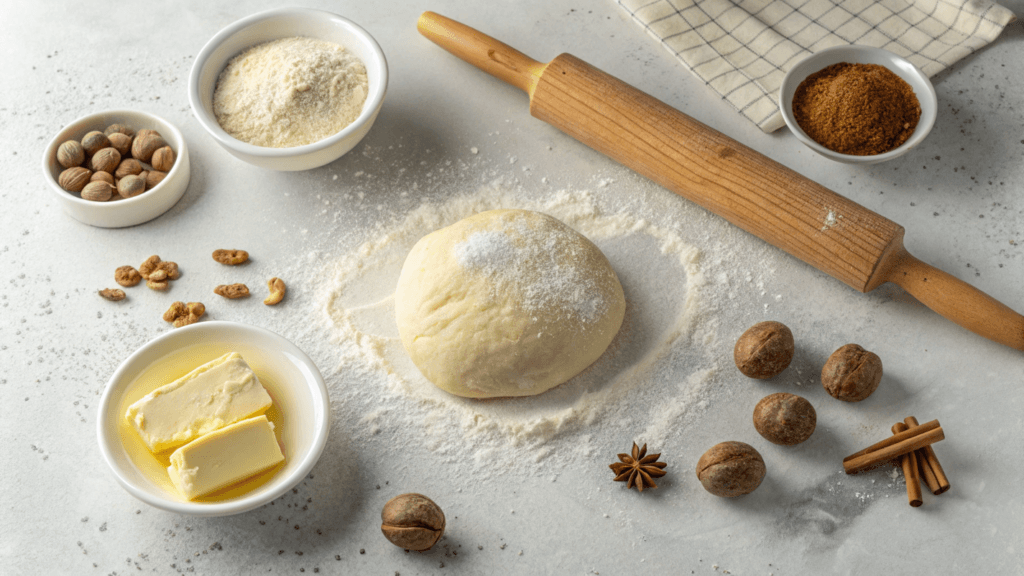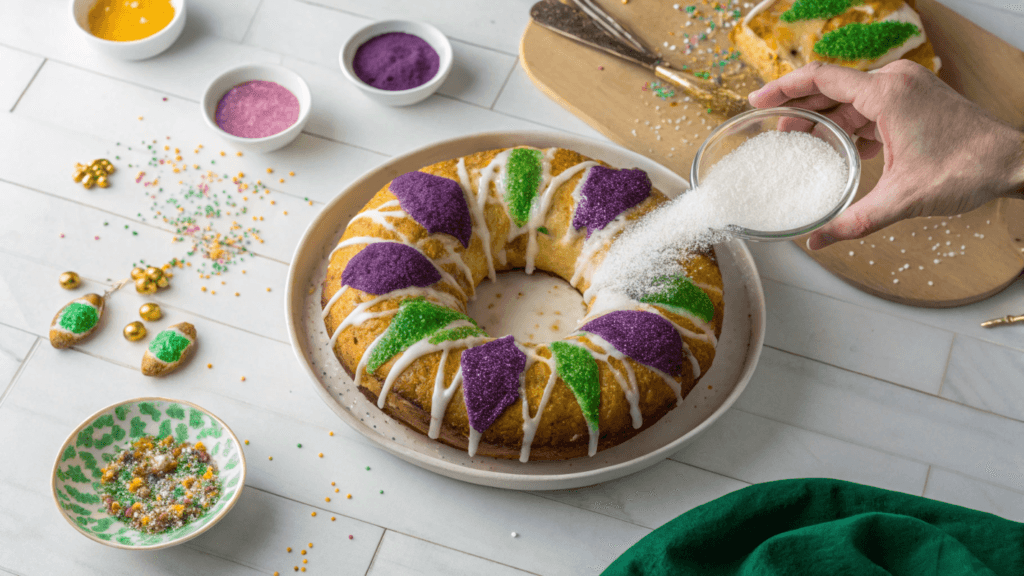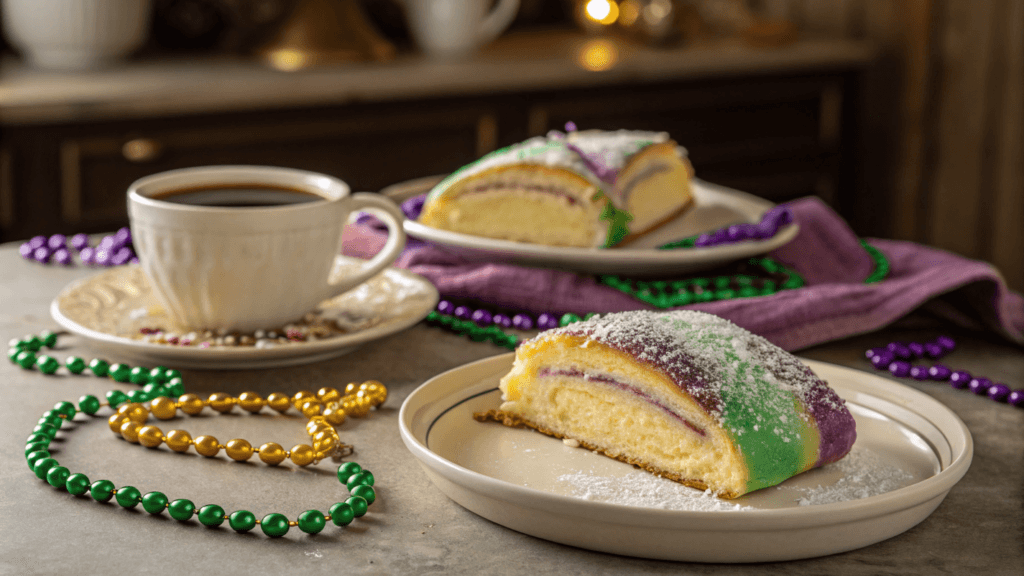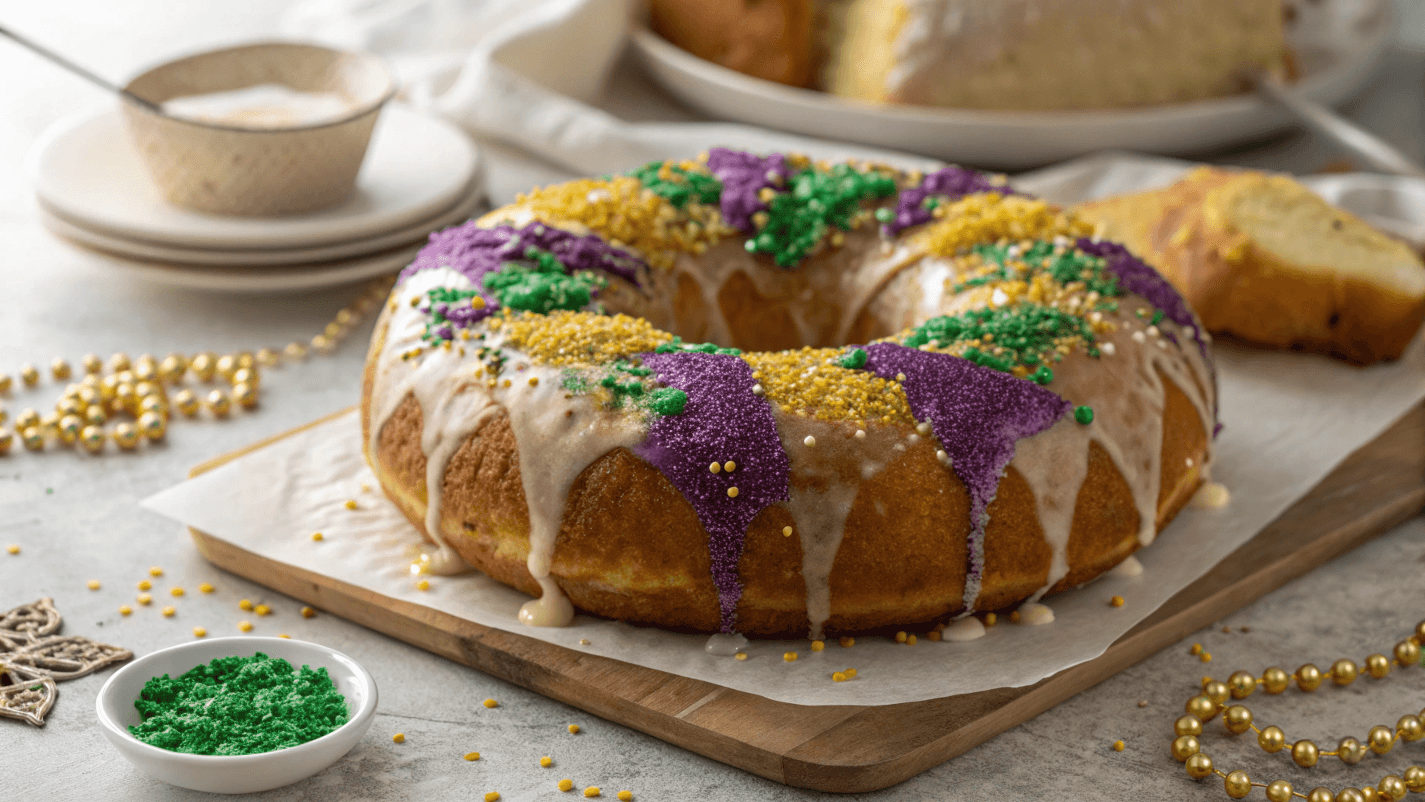King Cake isn’t just a dessert; it’s a celebration of culture, tradition, and community. This vibrant and festive treat, with its rich flavors and colorful decorations, holds a special place in Mardi Gras celebrations. Whether you’re preparing it to honor tradition or to try your hand at a beloved dessert, this king cake recipe will guide you through each step. From its historical significance to tips for making the perfect cake, let’s dive into the world of King Cake!
The Origins and Significance of King Cake
The History of King Cake
King Cake traces its roots to European Epiphany celebrations, symbolizing the arrival of the Three Kings. Over time, it became a cornerstone of Mardi Gras festivities in Louisiana. The cake’s oval shape represents unity, and its signature colors—purple for justice, green for faith, and gold for power—add a symbolic layer of meaning.
Symbolism Behind the Ingredients and Decorations
The hidden figurine or almond tucked inside the cake isn’t just a fun surprise. It symbolizes Baby Jesus, and whoever finds it is crowned “King” or “Queen” for the day. Traditionally, the lucky finder hosts the next King Cake party, keeping the festivities alive.
In this article, we’ll delve into a step-by-step guide for making the perfect king cake, along with tips to customize it to your taste. For those looking to experiment with other desserts, consider exploring this Cake Bar recipe for more ideas.
Key Ingredients for a Traditional King Cake
A successful king cake recipe starts with the right ingredients. From the dough to the filling and colorful decorations, each component plays a crucial role in achieving the perfect flavor and texture.
Essential Ingredients for the Dough
The dough forms the foundation of any great King Cake. Here’s what you’ll need:
- Flour: All-purpose flour works best for a tender yet sturdy dough.
- Yeast: Active dry yeast ensures the cake rises beautifully.
- Whole Milk: Adds richness and softness to the dough.
- Eggs and Butter: These create a moist, flavorful texture.
- Nutmeg and Cinnamon: A touch of spice elevates the overall flavor.
Filling Options: Classic Cinnamon or Creative Twists
While a cinnamon-sugar mix is the traditional filling, there’s room for creativity:
- Cream Cheese: Add a luscious layer of creaminess.
- Fruit Preserves: Strawberry, raspberry, or blueberry fillings provide a fruity punch.
- Chocolate: For a decadent twist, spread a thin layer of chocolate ganache.
Using fresh and high-quality ingredients will set your King Cake apart, whether you stick to tradition or try a new flavor combination.
For those who want unique baking inspiration, try this fun twist on traditional desserts with cookie cakes.
How to Make King Cake Dough
The dough-making process is crucial in a king cake recipe. It determines the texture and flavor of the final product. Let’s walk through the steps.
Preparing the Dough
- Scald the Milk: Heat whole milk until just before boiling, then let it cool. This step activates the yeast and enriches the dough.
- Mix the Ingredients: Combine the flour, yeast, sugar, eggs, butter, and spices in a large bowl. Mix until the dough begins to form.
Kneading and Rising
- Knead the Dough: Knead on a floured surface until it becomes smooth and elastic, about 8-10 minutes.
- Allow It to Rise: Place the dough in a greased bowl, cover with a clean towel, and let it rise for 1-2 hours until doubled in size.

This step sets the stage for the perfect texture—soft, airy, and ready to hold your filling of choice.
Traditional vs. Modern King Cake Variations
Classic Flavors and Techniques
When it comes to crafting the perfect king cake recipe, traditional flavors such as cinnamon, vanilla, and nutmeg often take center stage. These classic combinations evoke nostalgia and maintain the essence of Mardi Gras.
However, if you’re looking for more inspiration, explore how perfectly cooked thin sliced chicken breasts can be paired with rich Cajun spices for a savory twist. While not a conventional match, culinary creativity knows no bounds.
Creative Twists in Modern Recipes
Modern bakers have expanded the horizons of the king cake, incorporating everything from cream cheese fillings to praline toppings. These adaptations are perfect for parties or events where uniqueness is celebrated. Consider experimenting with fillings such as chocolate ganache or fresh fruit preserves for a personalized touch.
Decorating and Presenting Your King Cake
Creating Visual Appeal
The hallmark of a king cake is its vibrant icing, often in Mardi Gras hues of purple, green, and gold. To achieve the perfect drizzle, ensure your glaze is thick yet pourable. Add edible glitter or colored sugar for that extra sparkle, making your cake the centerpiece of any gathering.

Feel free to add edible glitter or colored icing for extra flair. For party inspiration, check out this gender reveal cake guide.
Incorporating Tradition in Presentation
A king cake isn’t complete without a small figurine or coin hidden within. This tiny surprise adds a playful element, especially for family events. Remember to inform your guests before serving to ensure everyone enjoys the experience safely.
Tips for Baking the Perfect King Cake
Ensuring Even Baking
One of the secrets to a successful king cake recipe lies in achieving even baking. Start by preheating your oven to the exact temperature specified in the recipe. Using an oven thermometer can help ensure accuracy, as even slight temperature variations can affect the texture and rise of the dough.
For best results, place your king cake on the middle rack. This position allows for optimal heat distribution, preventing over-browning or undercooked centers. Rotate the baking tray halfway through the process to ensure every side bakes evenly.
Avoiding Common Baking Mistakes
Mistakes happen, but a little preparation goes a long way. To avoid dense or dry cakes, don’t overmix the dough. Overworking it can lead to a tough texture, which is far from ideal. Instead, knead the dough gently until it’s smooth and elastic.
If your glaze tends to slide off the cake, allow the baked cake to cool completely before applying it. Warm cakes can cause the icing to melt, ruining the iconic look of your king cake recipe.
Storing and Reheating Your King Cake
Proper Storage Techniques
After indulging in your freshly baked king cake, you might find yourself with leftovers. To keep it fresh, wrap the cake tightly in plastic wrap or aluminum foil. Store it at room temperature if you plan to consume it within a day or two. For longer storage, transfer the wrapped cake to the fridge or freezer.
If your cake includes cream cheese filling, refrigeration is essential to prevent spoilage. Keep it in an airtight container to maintain its moisture and flavor.
Reheating for Maximum Freshness
When reheating slices of king cake, maintaining its soft texture and delicious flavor is key. Place the slices in a preheated oven at 300°F for 5–10 minutes. Cover them with foil to prevent drying out while warming evenly.

Microwaving is a quicker option, but it can make the cake slightly chewy. Heat each slice for about 10 seconds, checking frequently to avoid overheating. Whether you’re enjoying it fresh or reheated, the king cake recipe delivers a satisfying treat every time.
Creative Twists on the Traditional King Cake Recipe
Exploring Flavor Variations
The traditional king cake recipe is timeless, but why not explore some modern twists to keep things exciting? Consider adding new flavors to the filling, such as:
- Chocolate Hazelnut: A layer of creamy hazelnut spread can add decadence.
- Coconut and Pineapple: Bring tropical vibes to your King Cake by incorporating shredded coconut and pineapple jam.
- Pecan Praline: For a southern twist, sprinkle chopped pecans and drizzle caramel inside.
These variations not only elevate the flavor but also give your cake a unique touch that guests will rave about.
Experimenting with Shapes and Sizes
If you’re hosting a large gathering, consider making mini king cakes for individual servings. These are easier to share and maintain their festive appeal. Alternatively, try a braided design for a stunning visual effect. A braided cake allows the vibrant icing and sprinkles to cascade beautifully, creating an eye-catching dessert centerpiece.
FAQs About King Cake Recipe
1. What Makes a King Cake Different from Other Cakes?
A King Cake is a cross between a pastry and a bread, with a yeasted dough and traditional cinnamon filling. Its vibrant colors and hidden surprise distinguish it from other cakes.
2. Why Is a Baby Figurine Placed Inside the Cake?
The baby figurine symbolizes Baby Jesus and ties the King Cake to religious Epiphany celebrations. Today, it’s also a fun party tradition, with the finder of the figurine becoming “King” or “Queen” for the day.
3. Can I Make a King Cake Without a Mixer?
Absolutely! While a mixer can speed up the kneading process, you can achieve the same results by kneading the dough by hand. It just requires a bit more effort and patience.
4. How Can I Store Leftover King Cake?
Store the cake at room temperature for up to two days or refrigerate it for longer shelf life. If your cake has cream cheese filling, refrigeration is a must.
5. What’s the Best Way to Serve King Cake?
Serve King Cake at room temperature with a cup of coffee or a glass of sparkling wine. It’s the perfect sweet treat for any time of the day.


1 thought on “King Cake Recipe: A Mardi Gras Tradition”